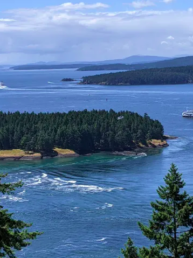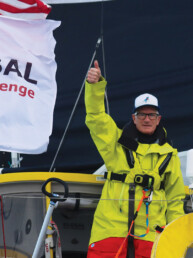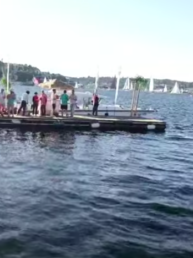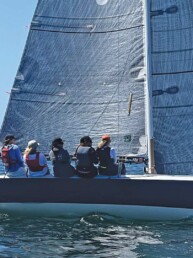This article was originally published in the December 2021 issue of 48° North.
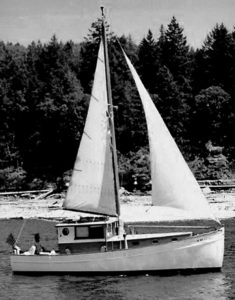
I thought I was done with old-boat restoration. But three years ago this month, while living in austere discomfort aboard a generic production boat, I found myself yearning for something with more soul…like an ancient wooden boat that needed “just a bit of work.” With experience giving new life to troubled boats — I’d retired after decades of restoration work — I was cautiously willing to consider another little project. Or maybe a slightly bigger one…
One day in early December, I spotted a tempting ad for WANDER, a 1933-built motorsailer on the Classic Yacht Association website. The boat was 29 feet overall with an attractive pilothouse, a low-hours Yanmar 30-hp diesel, freshly upholstered cushions, full boat cover, and other temptations. She was a John G. Alden design with sumptuous sheerline and ample cockpit; and had responsible, loving owners Gary and Merridy, who’d been forced by circumstance to let the boat go. After poring over details and photos, I somehow wrenched myself away from the ledge: Timing wasn’t right, I kept repeating. Besides, I couldn’t afford to deal with the midwinter sale of one boat and immediate assumption of what might be a daunting project.
Two weeks later, Steve, a boat-obsessed friend in Bellingham, sent me another ad for the same boat. A master at getting my attention, Steve cunningly said this was “your kind of boat,” and he asked if I’d already raced over to see the beauty in person? (And if not, why not?) I said okay, I’ll take another look, since the listing now featured even more photos. Blaming Steve for whatever might happen next, I contacted the seller to arrange for a quick look-see. Then, when I got to the marina slip in Everett, well, you guessed it — Game Over.
From the moment I stepped aboard WANDER, I felt a powerful, almost spooky bond with the boat’s blend of shapely curves and beefy, workboat scantlings. So, on the day after Christmas, 2018, I excitedly agreed to buy the old motorsailer, today renamed RAVEN, which had been built almost nine decades earlier at Todd Shipyards in Seattle for the then-president of the company. Planked in 1-1/8-inch Port Orford cedar over heavy white-oak frames, the boat was one of only two hulls known to have been built to Alden’s design #494 — Auxiliary Motor Cruiser.
 Todd Shipyards followed the original plan, building RAVEN with a modest trunk cabin forward, huge working cockpit, tiller steering, and sloop rig. Following the sudden death of the original owner only two years after completion, the boat disappeared for 25 long years — probably moldering somewhere on the lower Duwamish River, not far from where she was built. She was discovered, purchased and reworked starting in 1963 by a Boeing machinist who commissioned a shipwright at the Tripple & Everett yard to build a pilothouse that was aesthetically compatible with the original cuddy cabin. While the wheelhouse was being constructed, the owner rebuilt the original cabin interior, replacing everything with an abundance of fir plywood, 2x4s and faux walnut-grain laminate.
Todd Shipyards followed the original plan, building RAVEN with a modest trunk cabin forward, huge working cockpit, tiller steering, and sloop rig. Following the sudden death of the original owner only two years after completion, the boat disappeared for 25 long years — probably moldering somewhere on the lower Duwamish River, not far from where she was built. She was discovered, purchased and reworked starting in 1963 by a Boeing machinist who commissioned a shipwright at the Tripple & Everett yard to build a pilothouse that was aesthetically compatible with the original cuddy cabin. While the wheelhouse was being constructed, the owner rebuilt the original cabin interior, replacing everything with an abundance of fir plywood, 2x4s and faux walnut-grain laminate.
While the cabin’s interior arrangement might have been okay for our cruising plans — small galley, separate settee berths, cramped but functional head just aft of the chain locker — we could see the space needed a makeover if it was going to become a suitable liveaboard for one person, let alone three of us, including my partner Christina and her 11-year-old cat, Scout.
About two years ago, with a doodled cabin sketch in hand, I launched into a gut-out rebuild, hacking my way through the laminate, plywood and 2x4s until nothing remained but bare hull and frames.
Our plan was to add larger water and holding tanks; to increase room in the head by moving its bulkhead farther aft; to replace old 12v wiring; to install an efficient diesel heater; to design and build a generous galley with an 8-1/2-foot-long fir counter; to install new plumbing and a traditional galley hand pump that would economize on water usage; and to replace the Boeing guy’s MacGyvered mechanical-steering — (gearwheels, bicycle chains, pipes, pivot arms and a vintage truck steering gear) — with modern hydraulic steering. Oh, yes, and to install new engine controls, build a double berth with pull-out extension; add an array of vintage-style brass light fixtures, each with warm LEDs, and completely refinish the interior.
That was our “Day One” punchlist, outlined on a single page. By the time we moved aboard and savored our first cruise in September 2021, the To-Do list had expanded to half a dozen pages and 18 months had elapsed.
Work continues, but we’re tickled with early results and shockingly comfortable living aboard this small boat, in part because John Alden designed a hull whose beam is almost 10 feet, which is unusual in beam-to-length ratio for an early-1930s motorboat. Due to RAVEN’s surprisingly roomy-feeling interior, coupled with our new cabin arrangement, the boat is now just right — for us, at least — as both cruiser and liveaboard. In brief, this is what happened during RAVEN’s reconfiguration:
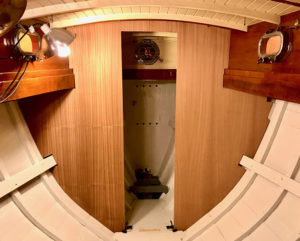
PHASE ONE — The Gut-Out
This stage went fast, since the goal was removal of the entire lower-cabin interior. Within the first week, I’d hauled more than 1,200 pounds of old boat to the dump. I was down to what appeared to be the original fir cabin sole, having scraped away patches of peeling linoleum and fake teak-and-holly
flooring. Still remaining at the aft end of the cabin was a substantial block of oak that had served as a keel-step for the boat’s original mast.
Because we were going with a pivoting tabernacle base the previous owner had installed on the foredeck, I found that by chiseling away the inner-keel mast step and removing what remained of the original cabin floor, I could build the new cabin sole directly on floor timbers and gain a full two inches of headroom. We aren’t especially tall, but those few inches made a subtle but significant difference when stepping into the cabin.

PHASE TWO — Framing the Interior
After emptying the cabin interior and scraping, sanding, and cleaning 88-years of grime, diesel-stove soot, and other schmutz from the planks and frames, we made patterns for the cabin sole and cut new floorboards. Once the floor was sealed and fastened down, we brought aboard the new 30-gallon water and holding tanks, made patterns and built the new head bulkhead, and started framing the galley and berth around the tanks — a water tank under the galley counter and holding tank beneath the starboard-side double berth.
It was slow going, since we needed to be sure our framing plan allowed the exact space needed for planned drawers, cupboard doors, a tilt-out galley garbage can, and Isotherm Cruise 36 1.3 cubic-foot drawer refrigerator. (Although small, we love the Isotherm, which operates on 12v or 110 and has a physically-separate compressor that is virtually silent when running.)
Once framing was finished, we started work on galley cupboard doors, built with 3/4-inch-thick Sapele mahogany and inset panels of 1/4-inch ribbon-grained mahogany plywood. Time elapsed while we sourced hinges, drawer pulls, and latches that all had the desired look (satin nickel), and additional days were spent fussing with dark mahogany stain colors and varnish; but the galley structure finally came together and was overlaid with a mahogany-ply sub-deck and 3/4-inch tongue-and-groove Douglas fir for the countertop. Brewing up and applying a warm, yellow-colored stain, we then applied four coats of Epifanes Matte varnish to the countertop. So far, so good in terms of durability.
The boat came to us with what had to be the original marine toilet, manufactured about 1930 by A.B. Sands & Son, New York City. After having the steampunkish old beast rebuilt at Marine Sanitation in Seattle, we remounted it a bit farther aft in the expanded head compartment (no more head-banging), and plumbed it to the new holding tank.
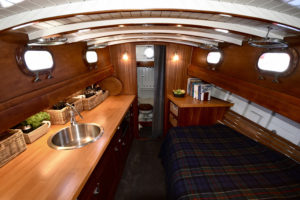
PHASE THREE — Systems
While carpentry work continued, we gradually ripped out and replaced almost 400 feet of ancient 12v wiring, and added classic brass light fixtures from Davey & Co. in London. A few additional vintage light fixtures, for the head and pilothouse, came from our friends at Longship Marine in Poulsbo, and all fixtures were converted to accommodate warm 12v LED bulbs. After installing the main cabin lights, we decided we’d like some additional soft lighting over the galley counter, so we worked with Dr. LED of Seattle to come up with three slim strip lights that provide a warm glow across the wide fir counter.
After disposing of the cranky old mechanical steering system, we bought a hydraulic steering hub, beefy cylinder and hoses, and linked everything to the transom-hung rudder. Then came one of our favorite items: The Wallas 30GB diesel heater from Scan Marine in Seattle, which involved routing three different heat ducts around the boat — one inside the pilothouse, another aimed into the main cabin, and a third in the head. The Wallas offers fuel-efficient, dry, fan-driven heat with even distribution throughout our boat. It’s operated from a small control panel mounted at one end of the galley, next to a Blue Sea Systems breaker panel, whose switches control electronics, heater, pilothouse light, DC refrigerator, cabin fan, engine room light, main cabin lights, navigation lights, anchor light, and accessories.
In order to complete rewiring and installation of the new hydraulic steering, together with contemporary throttle and shift controls linked to the little Yanmar, we built a new mahogany steering console in the pilothouse.
Hiding behind removable panels under the vintage bronze steering wheel (generously gifted by friends Chuck and Shalline) are buss bars where three deep-cycle AGM batteries rendezvous with a main switch.
Inside the small engine room we have the Yanmar 3YM30 diesel with less than 300 operating hours,
along with a ProMariner charger to keep the three AGMs topped off.

PHASE FOUR — The Near Future
Over this winter we’ll extend weather protection over what’s been an open cockpit. A new wood-framed, boom-supported, fabric-covered shelter will host flexible solar panels since our plan for 2022 is to spend time in remote backwaters of the British Columbia coast, away from marinas and 110v power.
We also plan to reinstall the motorsailer rig, which has consisted of a conventional sloop main with sizable jib. The jib has a boom that extends from the bow almost back to the pilothouse — about 13 feet. Our plan is to retain the jib, shorten the height of the mainmast by five feet, and possibly add a small mizzen whose mast would rise from the aft pilothouse bulkhead. The mizzen would mainly come into play when we’re at anchor — helping to prevent RAVEN from yawing all over the cove, at least when there’s a breeze.
When rigged, we know RAVEN will never be a real sailboat. She has a curvaceous hull shape but her keel only draws three feet, so she’ll be fine for occasional downwind runs or broad reaches. But she’s mostly a motorboat and she’ll remain so 95% of the time.
We love our old boat and savor life on the water, so the months of work have been worth every day, week,
month, and penny. Marina passersby often say nice things — “beautiful boat” or “keep up the good work” — but some question our sanity in owning, restoring, and now living aboard an old, relatively tiny 29-foot wooden boat with too much varnish. But, as 48° North readers know well, there are no maintenance-free boats — regardless of building material — and we’re lucky we love upkeep and restoration work, as well
as the semi-finished product.
Marty Loken
Marty Loken is the Associate Editor of Small Craft Advisor magazine, based in Port Townsend, Washington.

